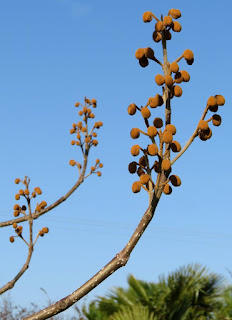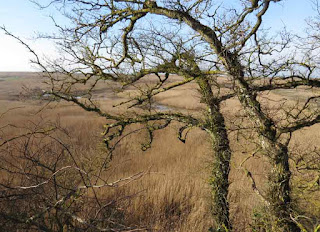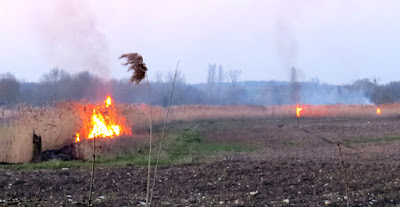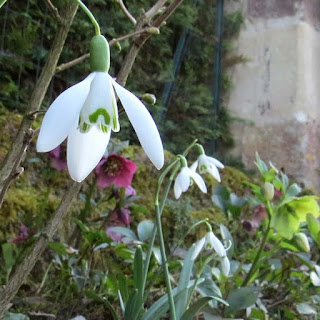"A garden is made up of a thousand interventions."- Anna Pavord
 |
| Fallen tree after a winter gale |
Tempêtes are regular events along this Atlantic coast during the winter months, often coinciding with very high tides which can cause flooding in low-lying areas such as ours.
We considered ourselves lucky to still have most of our roof tiles in place, unlike the terracotta ones on our front wall which - despite their weight - had just been lifted and dumped in the hedge behind, or else thrown into the road and broken in pieces.
We were helping to prune our friends' roses at the time, having enjoyed our first al fresco lunch on their terrace - in my case, wearing shades and a cap because it was actually hot!
Their almond tree was bursting into flower and this is possibly my favourite blossom as it comes so early, attracting insects from all around.
Paulownia is equally a handsome tree, originally from Asia but also popular in the eastern US, where it can grow up to 12 meters high when not impeded by other trees.
Luckily our friends have plenty of room in their garden and this one is already quite tall after a year or so.
I was struck by the exotic, furry buds which I presume will open to reveal large lilac flowers - hence its common name of 'foxglove tree'.
The RHS has given it the Award of Garden Merit and we would probably grow it ourselves if only we had the space!
When not stricken by disease, this type of elm can grow tall and straight to some 40m high, but nowadays they're generally just used for hedging as seen here.
Bird Life
Looking down from this hedgerow you have an extensive view of the marshes - or marais - below, and can often track a marsh harrier as it patrols up and down the water's edge, scanning for prey.
These reedbeds cover several hectares along the estuary and provide an important habitat for many birds including the Penduline tit, which I've mentioned before, and the Bluethroat which - annoyingly - we've yet to actually see!
Although we're surrounded by all manner of interesting birds, I guess we're not patient enough when it comes to spotting them.
A friend once advised us to 'stand still and let them come to you', which is quite right of course but just not compatible with taking a brisk walk for exercise.
Nevertheless, we usually have our 'bins' or camera at the ready in case something should happen to strike up a pose!
Gardens really benefit from thorough weeding and mulching in the fallow period of late winter when the soil is starting to warm up.
You can tell when beds become less sodden and more friable and that's the time to clear off any moss, cut down perennials and put some nice compost or well-rotted manure around your favourite plants.
I know I always mention hyacinths at this time of year and it's because we can never resist buying a few to scent the living room.
They're so much better value than a bunch of cut flowers from the supermarket!
Usually we find a spare bit of garden where we can bury them later as it would be wasteful just to chuck the bulbs afterwards.
They may come up a little smaller in subsequent years but, if anything the colour and scent is more intense, so we now cut these blooms to put in a vase and enjoy them for several days on the kitchen table.
Snowdrops are difficult to grow in this climate where the earth can become very hot and parched in summer.
But, to her great delight, Christina managed to establish a few bulbs out in the shady verge along our back lane.
What began with just a few hollyhock seeds tossed into the grass has now turned into a spring border of hellebores, primrose, pulmonaria and daffodils (Tête à tête) under a little hedge of Viburnum tinus. Nowhere is left fallow for long!
Something else that farmers do this time of year on a calm dry day ... This shot was taken behind our house where the fields are cultivated for sunflowers.
 |
| Bark and branches ripped from coastal pine trees |
Like the UK, we were battered by a fierce gale in early February which brought down trees, lifted tiles off roofs and generally scattered debris over the countryside.
Our neighbour, Robert, had two very tall trees uprooted and thrown across his river during the storm, as shown in the photo above.
The sprouting balls of mistletoe made it look quite picturesque but he was obviously going to have a job getting it off the water!
Closer to the sea-shore, pine trees were scarred by fierce gusts, leaving beaches strewn with pine cones, branches and piles of reeds mixed in with seaweed.
 |
| Retrieved tiles awaiting cement... |
We considered ourselves lucky to still have most of our roof tiles in place, unlike the terracotta ones on our front wall which - despite their weight - had just been lifted and dumped in the hedge behind, or else thrown into the road and broken in pieces.
Once the wind died down, it provided us with the necessary spur to tidy up the garden and give the wet grass a good raking.
 |
| The calm after the storm - a peaceful sunset at our local port |
 |
| Common cranes migrating |
Cranes sometimes fly overhead at this time of year, presumably heading for one of their favoured nest sites in N E France, the Lac du Der.
This was a fairly small V-formation of about twenty birds and their distinctive call - a sound of the wilderness - was enough to make us jump up from gardening and watch as they disappeared into the blue beyond.
We were helping to prune our friends' roses at the time, having enjoyed our first al fresco lunch on their terrace - in my case, wearing shades and a cap because it was actually hot!
Their almond tree was bursting into flower and this is possibly my favourite blossom as it comes so early, attracting insects from all around.
 |
| Paulownia tomentosa - producing fragrant flowers |
Luckily our friends have plenty of room in their garden and this one is already quite tall after a year or so.
I was struck by the exotic, furry buds which I presume will open to reveal large lilac flowers - hence its common name of 'foxglove tree'.
The RHS has given it the Award of Garden Merit and we would probably grow it ourselves if only we had the space!
 |
| Storm-ravaged elms surviving on the marais |
 |
| Pink elm blossoms (Ulmus procera) |
Trees of a very different kind are also in bud down on the marais and I wouldn't have recognised them as elms as it's so long since they were a common sight in England.
But Christina is more of a 'country girl' and she knew that despite their wizened shape, these trees were the so-called English elms of our childhood.
When not stricken by disease, this type of elm can grow tall and straight to some 40m high, but nowadays they're generally just used for hedging as seen here.
Bird Life
 |
| Marsh harrier (Circus aeruginosus) |
These reedbeds cover several hectares along the estuary and provide an important habitat for many birds including the Penduline tit, which I've mentioned before, and the Bluethroat which - annoyingly - we've yet to actually see!
 |
| The very common buzzard (Buteo buteo) - perched precariously on a small branch |
Although we're surrounded by all manner of interesting birds, I guess we're not patient enough when it comes to spotting them.
A friend once advised us to 'stand still and let them come to you', which is quite right of course but just not compatible with taking a brisk walk for exercise.
Nevertheless, we usually have our 'bins' or camera at the ready in case something should happen to strike up a pose!
 |
| The ex-raspberry corner now replanted with bulbs and perennials |
Gardens really benefit from thorough weeding and mulching in the fallow period of late winter when the soil is starting to warm up.
You can tell when beds become less sodden and more friable and that's the time to clear off any moss, cut down perennials and put some nice compost or well-rotted manure around your favourite plants.
 |
| A felt hare sniffing the hyacinths' perfume... ('Felting' was Christina's new project for winter when it was too cold to be in the garden!) |
They're so much better value than a bunch of cut flowers from the supermarket!
Usually we find a spare bit of garden where we can bury them later as it would be wasteful just to chuck the bulbs afterwards.
They may come up a little smaller in subsequent years but, if anything the colour and scent is more intense, so we now cut these blooms to put in a vase and enjoy them for several days on the kitchen table.
Snowdrops are difficult to grow in this climate where the earth can become very hot and parched in summer.
But, to her great delight, Christina managed to establish a few bulbs out in the shady verge along our back lane.
What began with just a few hollyhock seeds tossed into the grass has now turned into a spring border of hellebores, primrose, pulmonaria and daffodils (Tête à tête) under a little hedge of Viburnum tinus. Nowhere is left fallow for long!
 |
| A happy mix of hellebores lining the grass verge |
Something else that farmers do this time of year on a calm dry day ... This shot was taken behind our house where the fields are cultivated for sunflowers.
 |
| Reeds being burned off to open up the water channels for drainage |


No comments:
Post a Comment